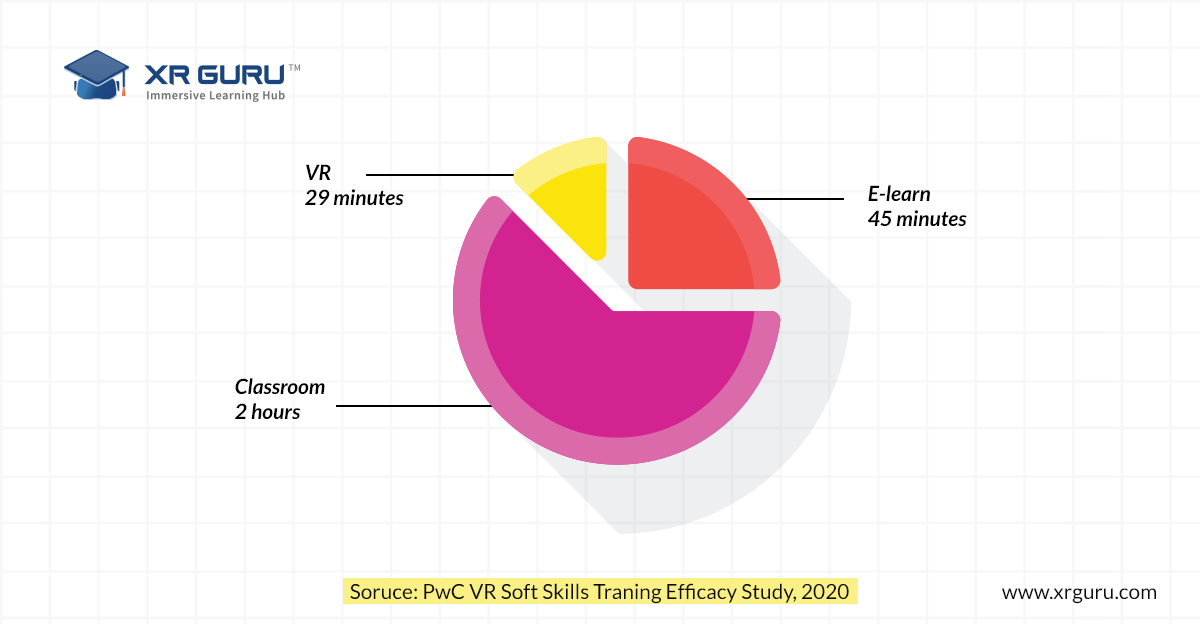Why Use Virtual Reality for OSHA Training- Learn How VR Training Can Make the Workplace Safer

When it comes to Health and Safety training, motivating and engaging employees in the training programs is a major challenge for organizations. Sometimes these training programs can lack relevance to real-life scenarios. Organizations are exploring different options to overcome these challenges, and virtual reality (VR) technology is emerging as an effective alternative to real-life training activities. In fact, a study shows that using virtual reality in Health & Safety training can improve employee safety. Immersive VR content has the potential to enhance the training experience and improve employee engagement levels, ensuring a better ROI on training programs.
Are you interested in adopting VR for OSHA (Occupational Safety and Health Administration) training?
On 28 July 2022, 01:30 p.m. EST, XR Guru is conducting a webinar on "Virtual Reality OSHA Training." Join our webinar to learn more about using virtual reality for corporate training.
Here is an Overview of Our Blog:
-
1. What is OSHA?
-
2. Why OSHA Training is Important
- 3. Drawbacks of Traditional Training
-
4. Using VR for OSHA Training
-
5. Benefits of Using VR for OSHA Training
-
5.1 Does Not Affect Productivity
-
5.2 Bridges the Virtual and Real World
- 5.3 Safety Training that's Safe
- 5.4 Practice Makes Perfect
-
5.5 Faster and Efficient Training
- 5.6 Cost-Effective
- 5.7 Detailed Analytics
- 6. The Bottom Line - VR Training Benefits Companies
1. What is OSHA?
The Occupational Safety and Health Administration (OSHA) is a regulatory agency of the United States Department of Labor; OSHA's goal is to guarantee safe and healthy working conditions for employees by enforcing standards and providing training, education, and assistance. OSHA training provides workers with basic and more advanced training about standard safety and health hazards in the workspace.
2. Why OSHA Training is Important
A report by Liberty Mutual Workplace Safety Index states that U.S. businesses spend more than one billion dollars a week on serious, nonfatal workplace injuries. OSHA training helps companies improve workplace safety and reduce the expenses of work-related injuries.

(Source)
OSHA training courses allow employees to learn about essential workplace guidelines such as emergency plans, first aid, hazard communication, fire protection, electrical safety, etc. OSHA training emphasizes working as a team to prevent potential accidents and hazards.
Some benefits of OSHA training in the workplace are as follows:
- Reduced workplace accidents
- Financial benefits
- Improved company standards
- Enhanced understanding of how to handle workplace hazards
3. Drawbacks of Traditional Training
For Health and Safety training, companies usually use a combination of classroom-based exercises and online content. For instance, employers can use videos, online quizzes, or manuals to educate an employee on workplace safety hazards. However, these conventional methods are often less effective, lack the ability to give hands-on experience, and cannot recreate a realistic work environment. Also, trainees show a lack of interest while learning through traditional methods.
Furthermore, hiring an instructor and acquiring materials are major business expenses in conventional training, and for all the money spent, organizations cannot measure learner engagement.
So, why spend money on ineffective training methods? Using VR is an efficient way to train employees, and it has the potential to overcome the challenges of traditional training courses.
Join our live webinar to learn more about using virtual reality for OSHA training.
4. Using VR for OSHA Training
In the modern era, no company is exempt from safety risks, and many companies work diligently to devise strategies to mitigate risks. Using virtual reality to train employees improves employee engagement while enabling them to interact with the virtual world just as they would in the physical world. The immersive nature of VR helps employees learn faster and retain information for a longer period. Compared to conventional training methods, trainees feel more immersed in the virtual environment and find the training worthwhile with VR.
5. Benefits of Using VR for OSHA Training
Utilizing virtual reality for OSHA training offers several advantages. Here are some benefits of adopting VR-based training programs:
5.1. Does Not Affect Productivity
When it comes to activities such as heavy machinery training, employers usually have to take a piece of equipment out of service so that it can be used for training. It can potentially interrupt the work process and affect productivity. By using virtual reality for training, this is no longer a concern for companies can run several simulations and train employees in a virtual world without having to take out real-life equipment at the cost of productivity. With VR, trainees can take a closer look at the equipment and learn how to operate it in a safe, virtual environment.
5.2. Bridges the Virtual and Real World
VR-based training programs provide an interim step between the classroom and the real world. Often a newly trained employee is not quite skilled enough to maneuver the equipment safely. Operating a device without the essential skills can cause injuries, property damage, or loss of productivity. With a VR application, employees do not have to switch back and forth between the actual job and training program. Virtual reality can help trainees practice in a safe, low-risk digital environment as often as necessary until they feel confident enough to operate the equipment in real life.
5.3. Safety Training That's Safe
In many cases, hands-on, practical Health and Safety training across sectors are quite simply unsafe. From working with hazardous equipment to working in dangerous environments or undertaking highly technical/ precision tasks where a minor error could cause severe damage, learning on the job is often out of the question.
The power of virtual reality applications offers a solution to this tricky problem. Real-life work scenarios can be replicated in the virtual world, enabling trainees to practice and sharpen their skills in a safe virtual bubble.
For instance, Verizon used virtual reality simulations to train and prepare its employees for risky scenarios like armed robberies. After these VR-based training sessions, it was found that almost 97% of employees were confident enough to face such situations in real life.
5.4. Practice Makes Perfect
Unlike conventional training techniques, the learning experience is not limited by time constraints. VR-based lessons can be accessed multiple times from anywhere, at any time convenient for the learner. With the help of VR, trainees can improve their knowledge and perfect their skills. In a virtual environment, employees can make mistakes and learn from them without causing harm to themselves or property. Further, VR experiences have key performance metrics that help to monitor/evaluate the trainees' knowledge and skills.
5.5. Faster & Efficient Training
VR-based OSHA training helps trainees master new skills faster and more effectively. Stats back up the claim that VR is a far faster method to develop new skills. A study by PwC shows that VR learners completed training 4 times faster than traditional classroom training.

(Source)
Moreover, virtual reality helps to retain information more efficiently. A report by National Training Laboratory shows that retention rates are significantly higher in VR learning (75%) compared to traditional learning techniques such as lectures (5%) and reading (10%).
5.6. Cost-Effective
Imagine you are a newly employed Driller on an offshore rig; what will you do if there is a fire accident? Unless properly trained, it is hard for employees to know how to react. But there are practical difficulties in training employees for such situations. Companies cannot set things on fire every time they want to train a new employee for a crisis scenario. Just using training manuals and videos is not as effective as VR. Virtual reality technology makes it possible to run simulations numerous times and train multiple employees at no additional cost. With VR equipment becoming cheaper by the day, adopting VR for training is cost-effective in the long run.
5.7. Detailed Analytics
Virtual reality training programs offer in-depth insights into trainee behavior that helps companies track the effectiveness of the training program. With VR, employers and trainers can observe individual trainees and provide feedback. Virtual reality training applications include key performance indicators and biometric measures such as eye and hand movement tracking, body temperature, heartbeat monitoring, etc. These metrics can help employers assess the trainees' ability to deal with a stressful virtual environment and enable companies to identify behavioral patterns that lead to success.
6. The Bottom Line - VR Training Benefits Companies
Never before has the power of VR-based corporate training been more obvious than it is today. VR facilitates a safe, low-risk training environment with tools to measure employee engagement and progress, setting the stage for an unprecedented training experience. Already multitude of industries are using virtual reality for Health and Safety training. The improved retention rate and the cost-effective nature of virtual reality imply that we will see more companies use virtual reality applications to train their employees.
So, what are you waiting for? Check out VR-based OSHA training today to improve your company's safety standards.
Do you want to adopt VR for OSHA training? XR Guru is an immersive learning hub that enables you to train your employees using life-like simulations. With tools to create immersive learning content and track user progress, XR Guru is your best choice to offer immersive workplace training.
Join Us for Our Next Webinar
Title: Virtual Reality OSHA Training
Transform Training Experience with Virtual Reality!
If you are exploring different ways to improve Health and Safety training, learn how to use virtual reality for OSHA training and the benefits of virtual reality-based training programs.
Join our live webinar to learn more about using virtual reality for OSHA training.
If you cannot attend, register anyway, and we will send you the recording.
Host: Doug Smith
When and Where:
01:30 p.m. EST, Thursday, July 28, 2022
25 Minutes
Zoom Link for Registration
Goal: To help companies understand how to use virtual reality for OSHA training and how it can help organizations improve their health and safety standards.
Who Should Join:
- Business and Industry Heads
- Senior Management Professionals
- Corporate Board Members
- Entrepreneurs
- Those aspiring to adopt VR in classrooms.
Highlights of the Webinar:
- Learn how to use virtual reality for OSHA training
- Learn how VR helps in employee training
- Learn the benefits of adopting VR for workforce training
- View samples of immersive content
- Learn how to access our free Authoring Tool
- View samples of content you can create in our Authoring Tool
Outcome: Attending this webinar can help you understand how virtual reality can offer your employees a better training experience.



Comments
Post a Comment